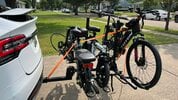I'd like to clarify further why I don't think 120lbs vertical load limit comes from Bosal. Adding some background..
I'm from Europe, Finland. Most cars have hitches here, In EU all hitch weight limits are part of vehicle type approval; they are already stated in car registration papers even if there is no factory hitch installed! Then you can go install aftermarket hitch and you can tow the amount specified in vehicle approval. So all hitches are the same; hitch manufacturer can not promise bigger tow weight than what's approved for the vehicle! Also lower weight spec is not possible, any hitch must be able to handle the weights specified in car approval papers.
Bosal is one of the most common brands of aftermarket hitches, and also indeed many OEM hitches are Bosal. They use the same kind of removal mechanism for their whole product range. Tesla is the only car brand to my knowledge that separately specifies tongue weight and vertical load limit, for all other car brands it's just the tongue weight that also limits bike racks.
I'm not sure if the Tesla vertical load limit is even legal. Model X has type approval for 2250kg (ˇ5000lbs) trailer weight and 90kg (200lbs) tongue weight. Legally this should mean that you can strap anything to the hook and it should stay there if it's under 90kg in weight. That's how the values are interpreted for any other brand car. Also this is probably the reason why they only specify 90kg tongue weight (200lbs) in Europe and 500lbs in the US...
Here's a picture of both US and Euro version of the OEM hitch. Euro version actually is currently manufactured by Oris, originally it was Bosal. These are my own; I bought the US version from ebay.
The part inside car bumper is identical, only difference between US and Euro is this removable part.
Euro part has the towing ball integrated. That's how they are in any brand car here, we don't use the 2" receivers. This might come as a shock to you Americans, but we actually connect our bike racks directly to the towing ball. Yes, to the round ball.
Below is a picture of my bike rack, which is "euro style" so it connects to the ball..
You can see the round hole there, you just stuff that around the towing ball, then tighten with the lever. There is a gripping mechanism that grabs the ball tightly.
This bike rack is approved for 60kg, so it's already above to 54kg limit set by Tesla. However it's below the 90kg vehicle type approval limit, so it is fully legal.
But... If you think about the joint between this bike rack and the round towing ball, and compare it to the Bosal removal mechanism, which one do you think will break first if I overload this and hit a big bump or something? Bike rack is approved for 60kg and Tesla hitch only for 54kg....
As I said earlier, exact same Bosal mechanism is used in many brand cars here and Tesla is the only one to have such low limit.



